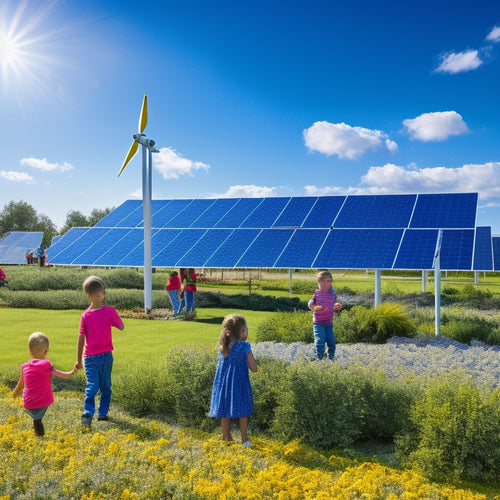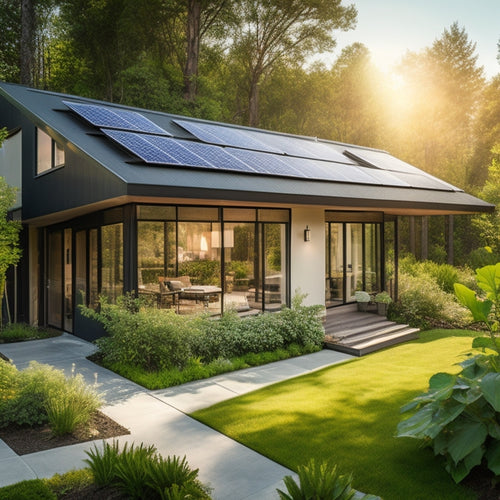
Setting Up a Solar System for Your Home in 3 Steps
Share
You'll set up a solar system for your home in 3 steps. First, assess your energy needs by reviewing past utility bills and identifying high-energy-consuming appliances for potential upgrades. Next, choose the right equipment, including solar panels, inverters, and battery storage, based on your energy requirements and efficiency needs. Finally, guarantee proper installation and maintenance to maximize system performance, including cleaning panels and scheduling annual professional checks, which will give you a solid foundation for a successful shift to renewable energy, and there's more to uncover about optimizing your system's potential.
Key Takeaways
- Assess your energy needs by reviewing past utility bills to determine the required solar system size and cost.
- Choose the right equipment, including high-efficiency solar panels and suitable inverters, to maximize energy production.
- Ensure proper installation and regular maintenance, including cleaning and annual inspections, to optimize system performance.
- Consider battery storage for energy independence during nighttime or outages.
- Utilize online tools and professional guidance to design an efficient system that meets your energy needs and budget.
Assess Your Energy Needs
Your energy consumption habits play a significant role in determining the size and cost of your solar system. The more energy you consume, the larger the system you'll need, and the higher the cost.
To get an accurate estimate of your energy needs, you'll need to conduct an efficiency analysis of your home's energy consumption.
Start by reviewing your past utility bills to understand your energy usage patterns. Identify the appliances and devices that consume the most energy and consider upgrading to energy-efficient alternatives.
You can also use online energy audit tools to get a better understanding of your energy consumption habits.
Choosing the Right Equipment
Considering the system's overall performance, selecting the right equipment is vital to utilizing the full potential of solar energy. You'll need to choose solar panels that match your energy requirements, taking into consideration factors like panel efficiency, durability, and warranty options.
Look for high-efficiency panels that can maximize energy production per unit area.
When it comes to inverter types, you'll need to decide between string inverters, microinverters, or power optimizers. Each has its advantages, so contemplate factors like system complexity, installation costs, and monitoring capabilities.
Battery storage is also essential for energy independence, allowing you to store excess energy generated during the day for use at night or during power outages.
To guarantee peak system efficiency, consider the overall system design, including panel layout, inverter configuration, and battery integration.
Be sure to research the manufacturer's warranty options and reputation for reliability. By choosing the right equipment, you'll be able to minimize your environmental impact while maximizing your energy savings.
With the right setup, you'll be well on your way to achieving energy independence.
Installation and Maintenance
The solar panel array's efficiency hinges on proper installation, which demands careful planning and execution.
You'll need to guarantee that your solar panels are installed at the ideal angle and direction to maximize energy production. During the installation process, your solar panels will be securely fastened to your roof, and the necessary electrical connections will be made.
Once your solar system is up and running, regular maintenance is essential to verify it operates at peak performance.
You'll need to clean your solar panels regularly to remove dirt and debris that can reduce energy output. Check your system's performance monitoring system regularly to identify any issues or malfunctions.
Additionally, schedule annual maintenance checks with a professional to inspect your system and perform any necessary repairs.
Frequently Asked Questions
Can I Install Solar Panels on a Rented Property?
You'll need to review your renter agreements to guarantee solar panel installation is allowed, as some landlords may have restrictions. However, you can still benefit from solar incentives, so it's worth exploring options with your landlord.
Do Solar Panels Work During Power Outages?
Like a knight in shining armor, solar panels come to the rescue during power outages - but only if you're connected to the grid. Unfortunately, standard solar panels won't provide power during outages, as they prioritize grid connection over individual efficiency.
How Long Does It Take to See Savings?
You'll start seeing energy savings shortly after installation, as your solar system reduces your reliance on the grid. A thorough cost analysis will help you pinpoint exactly when you'll break even, typically within 5-7 years, depending on your energy usage and local incentives.
Can I Use Solar Panels With a Septic System?
When you're considering a solar panel installation, you'll be relieved to know that it's compatible with your septic system; the two systems operate independently, so you can enjoy renewable energy without worrying about disrupting your septic system's functionality.
Are Solar Panels Pet-Friendly and Safe for Wildlife?
Oh, you're worried about Fido and Bambi? Relax, you're not installing a wildlife-killing, pet-pulverizing death trap on your roof. Solar panels are designed with wildlife safety in mind, minimizing impacts on local ecosystems, so you can power up guilt-free.
Conclusion
You've finally taken the leap to utilize the power of the sun. Now, bask in the glory of your reduced carbon footprint and lower energy bills. But let's be real, you're probably already thinking about how to monetize your new eco-friendly status on social media. Go ahead, post that Instagram selfie with your solar panels and caption it "Saving the planet, one watt at a time." You've earned it.
Related Posts
-

Solar Power for Community Energy Independence
Solar power is essential for your community's energy independence, offering both environmental and economic benefits....
-

Integrating Solar Panels Into Home Design
Integrating solar panels into your home design greatly enhances energy efficiency and lowers utility bills while addi...
-

High-Performance Energy-Efficient HVAC Systems
High-performance energy-efficient HVAC systems are essential for reducing energy consumption while improving indoor c...


